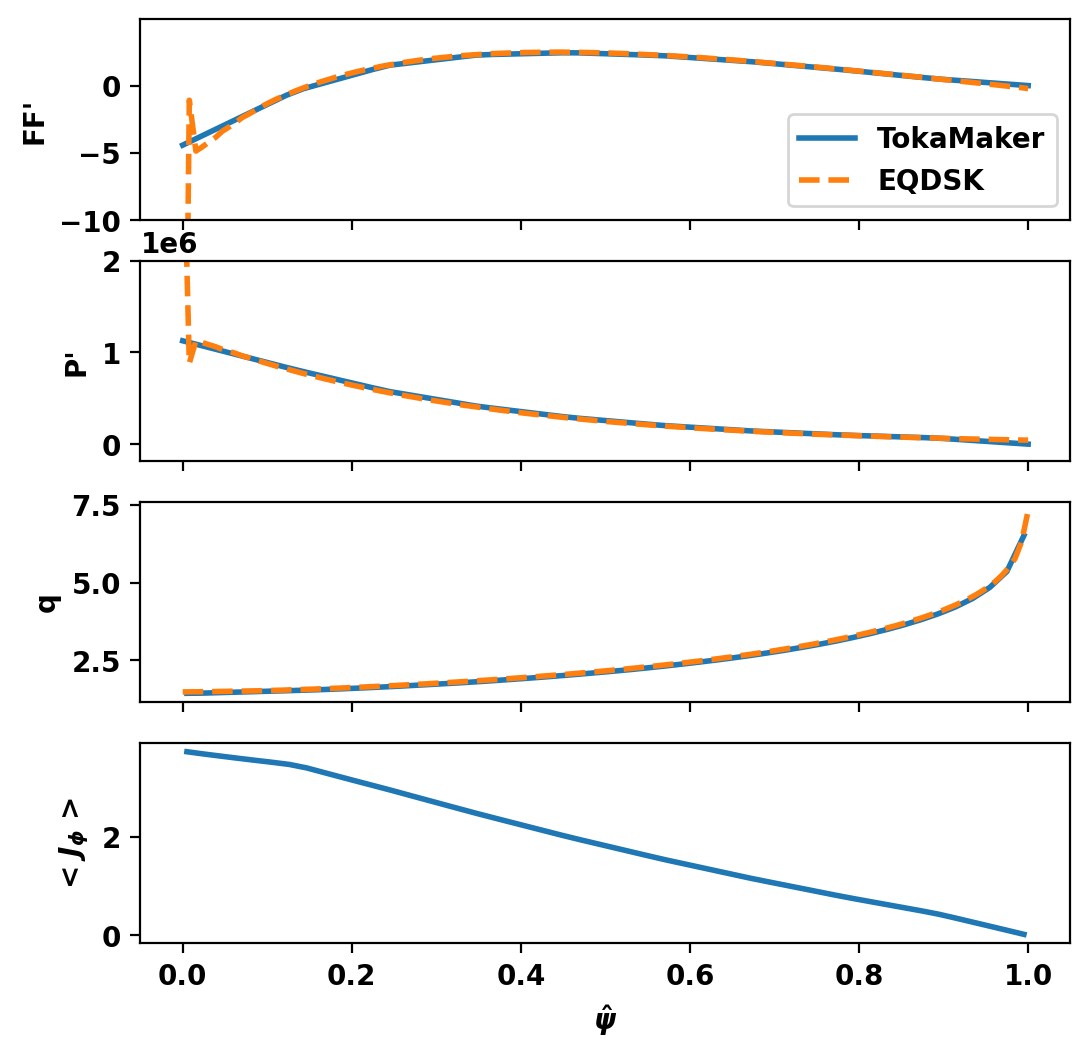In this example we show how to compute fixed-boundary equilibria using TokaMaker for:
- Equilibrium in an analytic boundary shape with chosen Ip, approximate \(\beta\), and flux profiles
- Recreation of equilibrium from an gEQDSK file, matching global quantities and profiles
Load TokaMaker library
To load the TokaMaker python module we need to tell python where to the module is located. This can be done either through the PYTHONPATH environment variable or using within a script using sys.path.append() as below, where we look for the environement variable OFT_ROOTPATH to provide the path to where the OpenFUSIONToolkit is installed (/Applications/OFT on macOS).
For meshing we will use the gs_Domain class to build a 2D triangular grid suitable for Grad-Shafranov equilibria. This class uses the triangle code through a simple internal python wrapper within OFT.
Create mesh
First we define a target size to set the resolution in our grid. This variable will be used later and represent the target edge size within our mesh, where units are in meters. In this case we are using a fairly coarse resolution of 1.5 cm (10 radial points). Note that when setting up a new machine these values will need to scale with the overall size of the device/domain. It is generally a good idea perform a convergence study, by increasing resolution (decreasing target size) by at least a factor of two in all regions, when working with a new geometry to ensure the results are not sensitive to your choice of grid size.
Define boundary
For this example we will first generate a mesh for fixed-boundary calculation using the simple flux surface definition in create_isoflux. This function parameterizes a surface using a center point (R,Z), minor radius (a), and elongation and triangularity, which can can optionally have different upper and lower value. For this case we make a plasma comparable to those generated in the LTX- \(\beta\) device at the Princeton Plasma Physics Laboratory.
Define regions and attributes
We now create the mesh object and define the various logical mesh regions. In this case we only have one region, which is named plasma and is of type plasma. See other examples for more complex cases with other region types.
Define geometry for region boundaries
Once the region types and properties are defined we now define the geometry of the mesh using shapes and references to the defined regions.
Generate mesh
Now we generate the actual mesh using the build_mesh method. This step may take a few moments as triangle generates the mesh.
Note that, as is common with unstructured meshes, the mesh is stored a list of points mesh_pts of size (np,2), a list of cells formed from three points each mesh_lc of size (nc,3), and an array providing a region id number for each cell mesh_reg of size (nc,), which is mapped to the names above using the coil_dict and cond_dict dictionaries.
Assembling regions: # of unique points = 76 # of unique segments = 1 Generating mesh: # of points = 700 # of cells = 1322 # of regions = 1
Plot resulting regions and grid
We now plot the mesh to inspect proper generation.
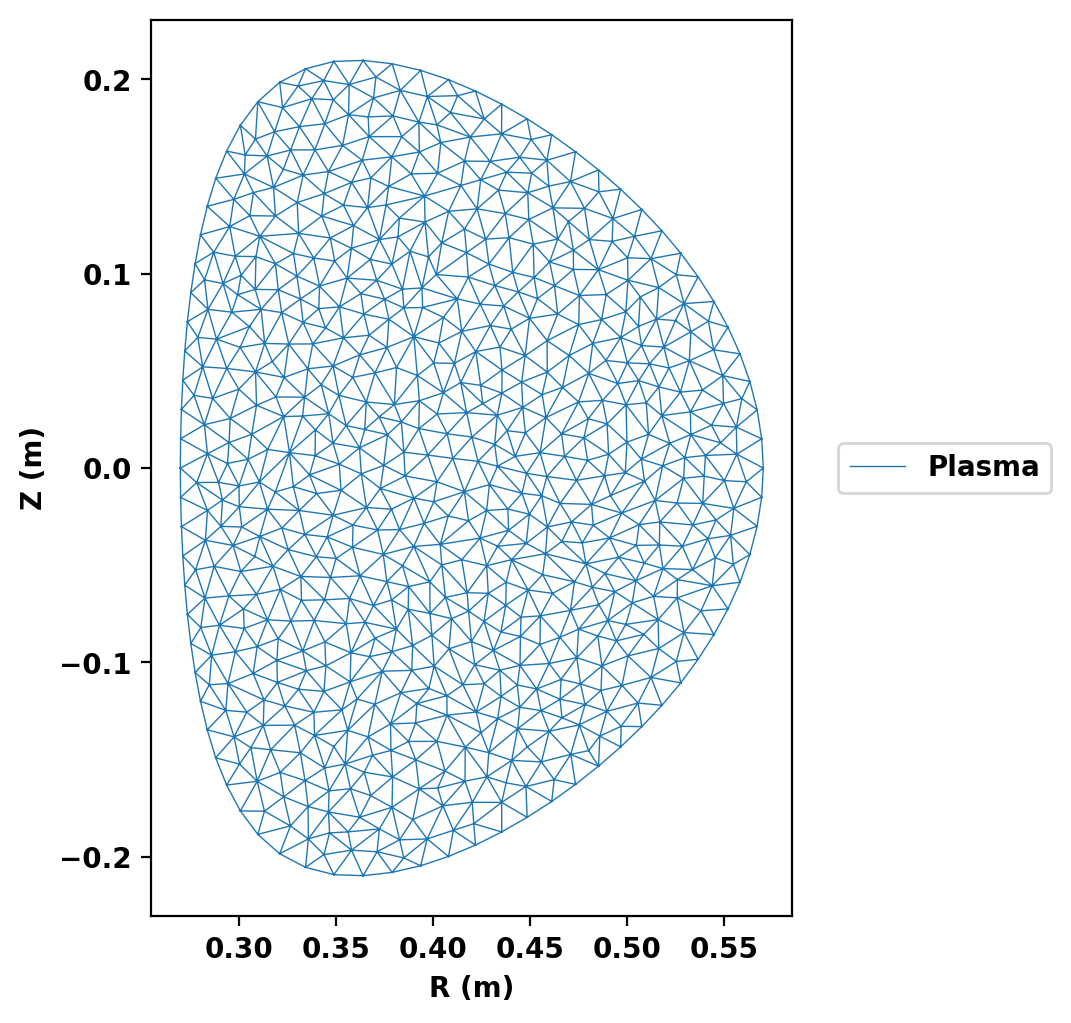
Compute equilibria
Initialize TokaMaker object
We now create a OFT_env instance for execution using two threads and a TokaMaker instance to use for equilibrium calculations. Note at present only a single TokaMaker instance can be used per python kernel, so this command should only be called once in a given Jupyter notebook or python script. In the future this restriction may be relaxed.
#---------------------------------------------- Open FUSION Toolkit Initialized Development branch: v1_beta6 Revision id: 681e857 Parallelization Info: # of MPI tasks = 1 # of NUMA nodes = 1 # of OpenMP threads = 2 Fortran input file = /var/folders/52/n5qxh27n4w19qxzqygz2btbw0000gn/T/oft_64627/oftpyin XML input file = none Integer Precisions = 4 8 Float Precisions = 4 8 16 Complex Precisions = 4 8 LA backend = native #----------------------------------------------
Load mesh into TokaMaker
Now we load the mesh generated above using setup_mesh and set the code to operate in fixed boundary mode by setting the free_boundary setting to False. Finally, we call setup to setup the required solver objects. During this call we can specify the desired element order (min=2, max=4) and the toroidal field through F0 = B0*R0, where B0 is the toroidal field at a reference location R0.
**** Loading OFT surface mesh
**** Generating surface grid level 1
Generating boundary domain linkage
Mesh statistics:
Area = 9.667E-02
# of points = 700
# of edges = 2021
# of cells = 1322
# of boundary points = 76
# of boundary edges = 76
# of boundary cells = 76
Resolution statistics:
hmin = 9.333E-03
hrms = 1.360E-02
hmax = 2.161E-02
Surface grounded at vertex 1
**** Creating Lagrange FE space
Order = 2
Minlev = -1
Define global quantities and targets
For the Grad-Shafranov solve we define targets for the plasma current and the ratio the F*F' and P' contributions to the plasma current, which is approximately related to \(\beta_p\) as Ip_ratio = \(1/\beta_p - 1\).
Initialize the flux function
Before running a calculation for the first time we must initialize the flux function \(\psi\), which can be done using init_psi. By default this calculation uses a uniform current (equal to Ip_target) over the full plasma domain. Additional options are also availble to tailor this distribution for more control.
Compute a fixed-boundary equilibrium
Now we can compute an equilibrium in this geometry using the default profiles for F*F' and P' by running solve.
Starting non-linear GS solver
1 4.9079E-01 1.4938E+00 3.4660E-04 4.3167E-01 -5.1820E-06 0.0000E+00
2 5.1357E-01 1.5554E+00 1.0505E-04 4.3201E-01 -6.8745E-06 0.0000E+00
3 5.2022E-01 1.5729E+00 3.3315E-05 4.3217E-01 -7.6919E-06 0.0000E+00
4 5.2231E-01 1.5783E+00 1.0910E-05 4.3223E-01 -8.0980E-06 0.0000E+00
5 5.2298E-01 1.5800E+00 3.6492E-06 4.3226E-01 -8.2974E-06 0.0000E+00
6 5.2320E-01 1.5805E+00 1.2387E-06 4.3227E-01 -8.3937E-06 0.0000E+00
7 5.2327E-01 1.5807E+00 4.2531E-07 4.3228E-01 -8.4396E-06 0.0000E+00
Timing: 1.5753999992739409E-002
Source: 7.4689999455586076E-003
Solve: 2.6430000434629619E-003
Boundary: 8.5599999874830246E-004
Other: 4.7860000049695373E-003
Print information and plot equilibrium
After computing the equilibrium, basic parameters can be displayed using the print_info method. For access to these quantities as variables instead the get_stats can be used.
Flux surfaces can be plotted using the plot_psi method. Additional plotting methods are also available to display other information for more complex cases. See other examples and the documentation for more information.
Equilibrium Statistics: Topology = Limited Toroidal Current [A] = 1.2000E+05 Current Centroid [m] = 0.412 0.000 Magnetic Axis [m] = 0.432 -0.000 Elongation = 1.398 (U: 1.398, L: 1.398) Triangularity = 0.375 (U: 0.376, L: 0.373) Plasma Volume [m^3] = 0.246 q_0, q_95 = 0.537 1.077 Plasma Pressure [Pa] = Axis: 1.0094E+04, Peak: 1.0094E+04 Stored Energy [J] = 1.3027E+03 <Beta_pol> [%] = 51.1582 <Beta_tor> [%] = 13.5361 <Beta_n> [%] = 4.3317 Diamagnetic flux [Wb] = 1.4761E-03 Toroidal flux [Wb] = 2.8060E-02 l_i = 0.7708

Generate fixed-boundary equilibrium from gEQDSK file
Read equilibrium from gEQDSK file
This time instead of an analytic boundary we will use the boundary from a previously computed equilibrium. To do this we load a gEQDSK file for a negative triangularity equilbirium. In EQDSK files the plasma boundary is stored in the variable rzout, which we set to be the LCFS_contour.
As this case is larger we also use a larger target size for the mesh
Define and generate mesh
As above we now define a mesh from this boundary and generate a new computational mesh.
Assembling regions: # of unique points = 67 # of unique segments = 1 Generating mesh: # of points = 488 # of cells = 907 # of regions = 1
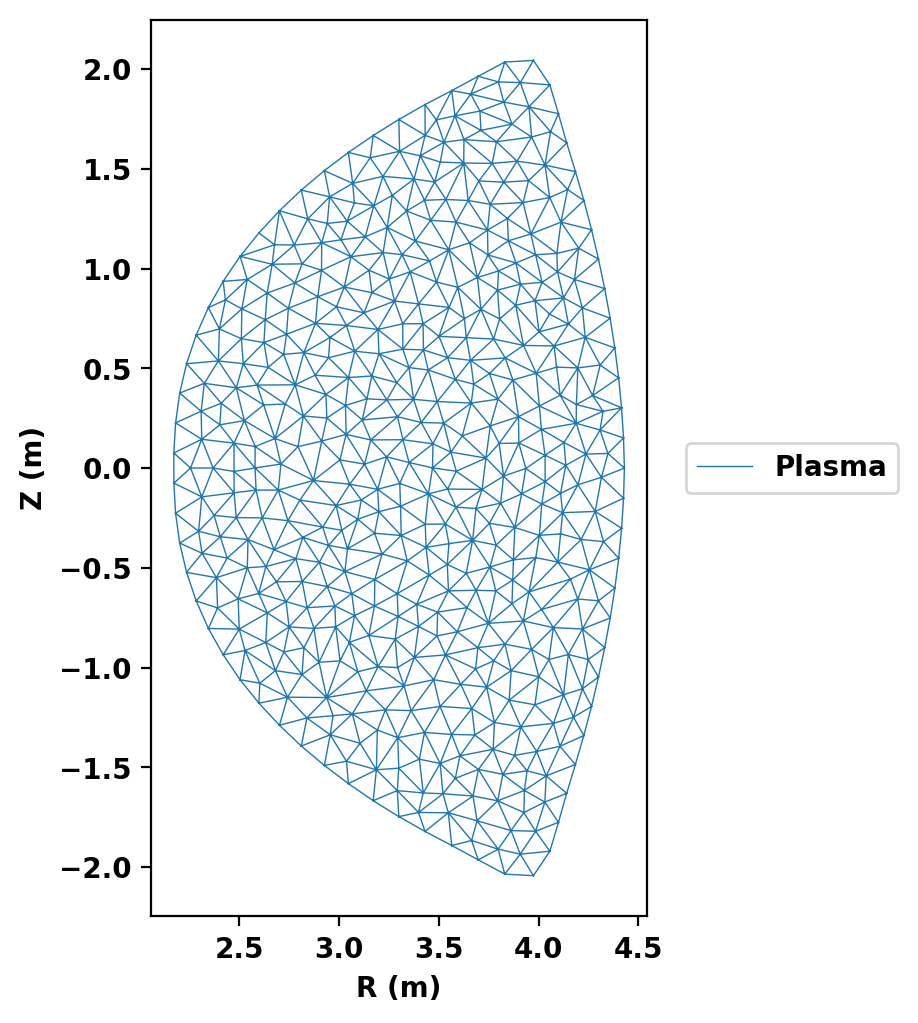
Update mesh in TokaMaker
To update the mesh in TokaMaker we must first call reset to clear the prior representation and prepare TokaMaker to accept a new configuration. Then we load in the new mesh as above using the B0 and R0 values for the input equilibrium to define F0. In this case we also increase the maximum number of solver iterations as well as the profiles use below converge somewhat slower than the defaults.
**** Loading OFT surface mesh
**** Generating surface grid level 1
Generating boundary domain linkage
Mesh statistics:
Area = 6.627E+00
# of points = 488
# of edges = 1394
# of cells = 907
# of boundary points = 67
# of boundary edges = 67
# of boundary cells = 67
Resolution statistics:
hmin = 9.316E-02
hrms = 1.363E-01
hmax = 2.174E-01
Surface grounded at vertex 34
**** Creating Lagrange FE space
Order = 2
Minlev = -1
Define global quantities and targets
Again we define a target for the plasma current, but instead of a target Ip_ratio we target a given pressure on the magnetic axis. Both values are set equal to the input equilibrium.
Compute a fixed-boundary equilibrium
Now we can compute an equilibrium in this geometry, as above, using the default profiles for F*F' and P'. Note that as we updated the mesh we must call the flux function initialization method before this solve.
Starting non-linear GS solver
1 -6.0903E+00 6.0973E-01 3.8521E-02 3.5785E+00 9.1950E-04 0.0000E+00
2 -2.7057E+00 4.7616E-01 8.9093E-03 3.5758E+00 8.0435E-04 0.0000E+00
3 -2.0621E+00 4.5264E-01 4.2214E-03 3.5687E+00 6.0357E-04 0.0000E+00
4 -1.8881E+00 4.4648E-01 1.9706E-03 3.5645E+00 4.9471E-04 0.0000E+00
5 -1.8327E+00 4.4457E-01 8.6951E-04 3.5625E+00 4.4383E-04 0.0000E+00
6 -1.8131E+00 4.4392E-01 3.7096E-04 3.5616E+00 4.2136E-04 0.0000E+00
7 -1.8057E+00 4.4367E-01 1.5555E-04 3.5613E+00 4.1171E-04 0.0000E+00
8 -1.8028E+00 4.4358E-01 6.4620E-05 3.5611E+00 4.0760E-04 0.0000E+00
9 -1.8017E+00 4.4354E-01 2.6703E-05 3.5610E+00 4.0584E-04 0.0000E+00
10 -1.8012E+00 4.4352E-01 1.1001E-05 3.5610E+00 4.0508E-04 0.0000E+00
11 -1.8010E+00 4.4352E-01 4.5235E-06 3.5610E+00 4.0475E-04 0.0000E+00
12 -1.8009E+00 4.4351E-01 1.8578E-06 3.5610E+00 4.0461E-04 0.0000E+00
13 -1.8009E+00 4.4351E-01 7.6244E-07 3.5610E+00 4.0454E-04 0.0000E+00
Timing: 1.3554000004660338E-002
Source: 8.0539998598396778E-003
Solve: 2.3829999845474958E-003
Boundary: 6.4800010295584798E-004
Other: 2.4690000573173165E-003
Print information and plot equilibrium
Equilibrium Statistics: Topology = Limited Toroidal Current [A] = 7.7993E+06 Current Centroid [m] = 3.531 0.000 Magnetic Axis [m] = 3.561 0.000 Elongation = 1.809 (U: 1.809, L: 1.810) Triangularity = -0.592 (U: -0.591, L: -0.592) Plasma Volume [m^3] = 141.437 q_0, q_95 = 2.077 4.961 Plasma Pressure [Pa] = Axis: 1.4277E+06, Peak: 1.4277E+06 Stored Energy [J] = 1.0252E+08 <Beta_pol> [%] = 128.9709 <Beta_tor> [%] = 1.4354 <Beta_n> [%] = 1.9119 Diamagnetic flux [Wb] = -7.7063E-02 Toroidal flux [Wb] = 6.0966E+01 l_i = 0.8216
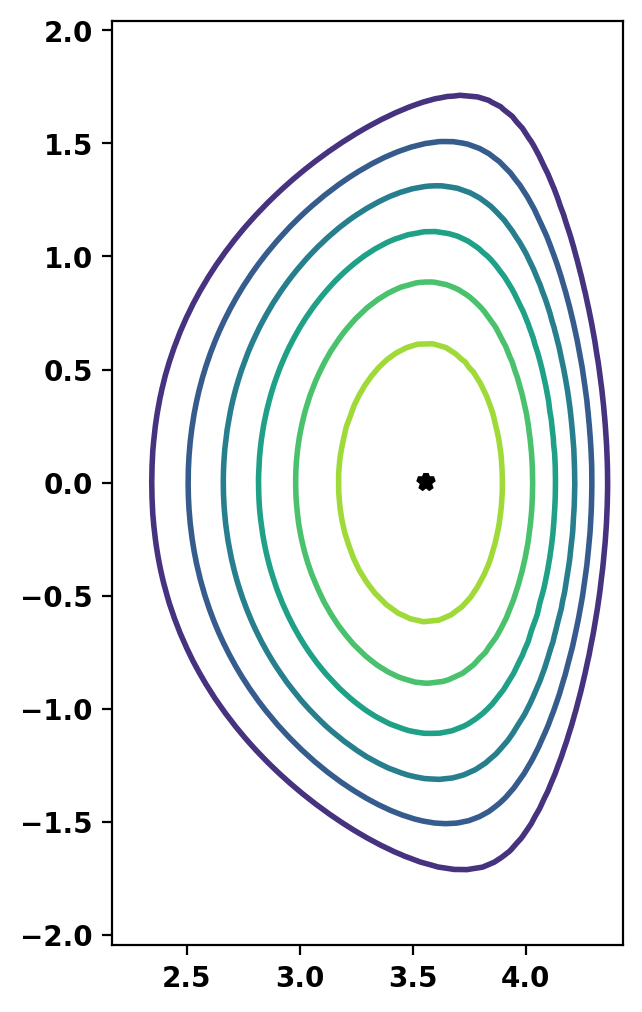
Compare flux profiles
We now use get_profiles and get_q to retrieve the F, F', P, P', and q profiles as a function of normalized poloidal flux. We then plot these against the corresponding profiles from the input equilibrium.
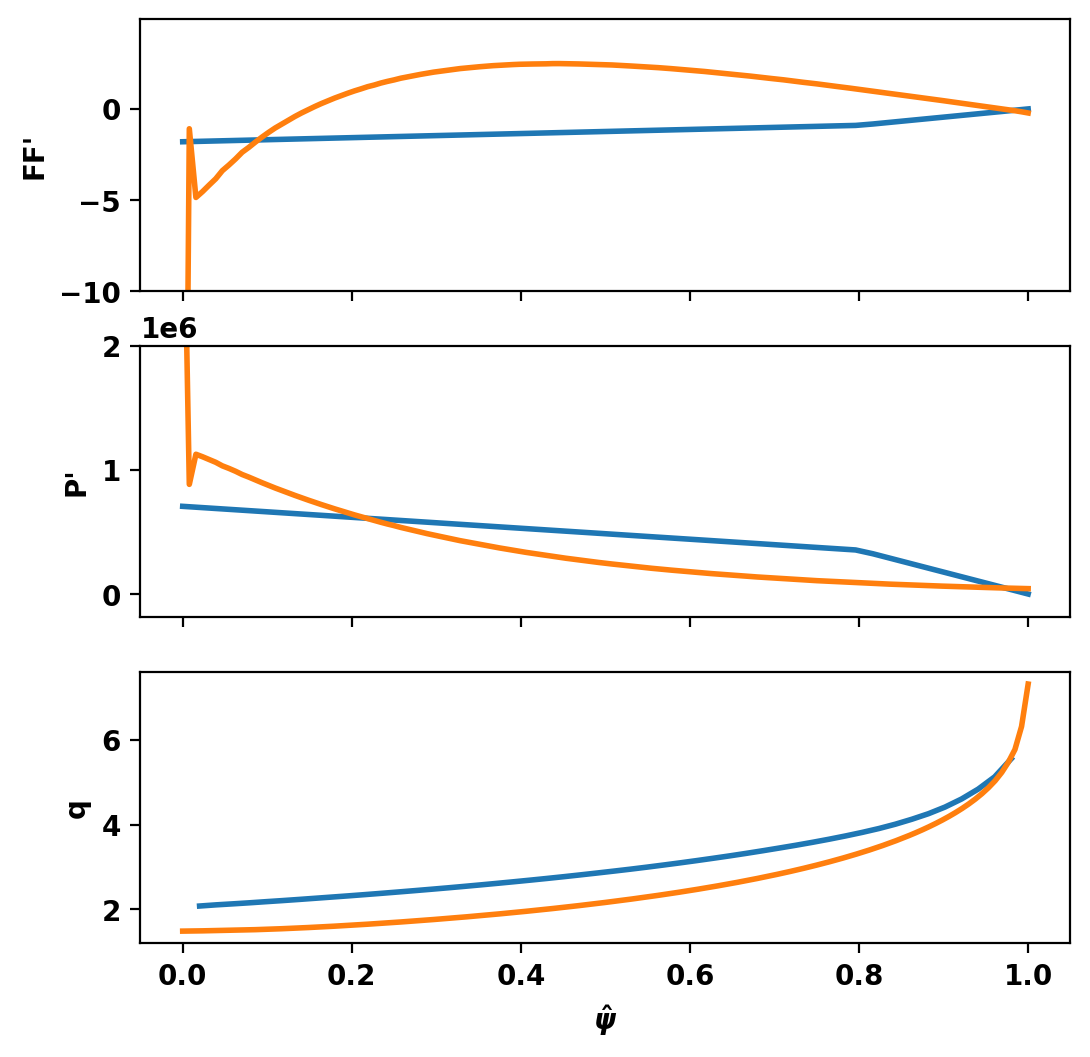
Match flux profiles
The F*F', P', and q profiles do not match the input equilibrium, so now we change the F*F', and P' profiles to match those in the input equilibrium. To do this we will use the linterp profile type that defines profiles as piecewise linear functions. Additionally, we force the profiles to go to zero at the plasma boundary and clip the input profiles near the core to avoid some oscillations present in this region.
Resolve equilibrium
Starting non-linear GS solver
1 5.6477E+00 1.7697E+00 9.6820E-02 3.5615E+00 1.5868E-04 0.0000E+00
2 -1.8545E+01 1.1764E+00 8.8806E-02 3.5140E+00 -1.7736E-04 0.0000E+00
3 -2.4156E+00 1.5345E+00 4.8690E-02 3.5280E+00 -2.1277E-04 0.0000E+00
4 -1.3595E+01 1.2978E+00 3.7250E-02 3.5171E+00 -2.5072E-04 0.0000E+00
5 -5.2918E+00 1.4861E+00 2.6241E-02 3.5243E+00 -2.5657E-04 0.0000E+00
6 -1.1458E+01 1.3516E+00 1.9528E-02 3.5192E+00 -2.4448E-04 0.0000E+00
7 -6.8945E+00 1.4557E+00 1.4205E-02 3.5232E+00 -2.5000E-04 0.0000E+00
8 -1.0270E+01 1.3808E+00 1.0504E-02 3.5206E+00 -2.3582E-04 0.0000E+00
9 -7.7784E+00 1.4374E+00 7.7112E-03 3.5228E+00 -2.4049E-04 0.0000E+00
10 -9.6174E+00 1.3963E+00 5.6915E-03 3.5213E+00 -2.3286E-04 0.0000E+00
11 -8.2612E+00 1.4270E+00 4.1900E-03 3.5225E+00 -2.3263E-04 0.0000E+00
12 -9.2615E+00 1.4045E+00 3.0903E-03 3.5217E+00 -2.2861E-04 0.0000E+00
13 -8.5240E+00 1.4212E+00 2.2772E-03 3.5223E+00 -2.2910E-04 0.0000E+00
14 -9.0677E+00 1.4090E+00 1.6789E-03 3.5219E+00 -2.2666E-04 0.0000E+00
15 -8.6669E+00 1.4180E+00 1.2375E-03 3.5222E+00 -2.2725E-04 0.0000E+00
16 -8.9624E+00 1.4114E+00 9.1216E-04 3.5220E+00 -2.2575E-04 0.0000E+00
17 -8.7446E+00 1.4163E+00 6.7227E-04 3.5221E+00 -2.2631E-04 0.0000E+00
18 -8.9051E+00 1.4127E+00 4.9549E-04 3.5220E+00 -2.2543E-04 0.0000E+00
19 -8.7868E+00 1.4153E+00 3.6518E-04 3.5221E+00 -2.2582E-04 0.0000E+00
20 -8.8740E+00 1.4134E+00 2.6915E-04 3.5220E+00 -2.2538E-04 0.0000E+00
21 -8.8098E+00 1.4148E+00 1.9836E-04 3.5221E+00 -2.2561E-04 0.0000E+00
22 -8.8571E+00 1.4138E+00 1.4620E-04 3.5220E+00 -2.2538E-04 0.0000E+00
23 -8.8222E+00 1.4145E+00 1.0775E-04 3.5221E+00 -2.2550E-04 0.0000E+00
24 -8.8479E+00 1.4140E+00 7.9414E-05 3.5221E+00 -2.2538E-04 0.0000E+00
25 -8.8290E+00 1.4144E+00 5.8529E-05 3.5221E+00 -2.2546E-04 0.0000E+00
26 -8.8430E+00 1.4141E+00 4.3137E-05 3.5221E+00 -2.2539E-04 0.0000E+00
27 -8.8327E+00 1.4143E+00 3.1793E-05 3.5221E+00 -2.2543E-04 0.0000E+00
28 -8.8403E+00 1.4141E+00 2.3432E-05 3.5221E+00 -2.2540E-04 0.0000E+00
29 -8.8347E+00 1.4143E+00 1.7269E-05 3.5221E+00 -2.2542E-04 0.0000E+00
30 -8.8388E+00 1.4142E+00 1.2728E-05 3.5221E+00 -2.2540E-04 0.0000E+00
31 -8.8357E+00 1.4142E+00 9.3806E-06 3.5221E+00 -2.2541E-04 0.0000E+00
32 -8.8380E+00 1.4142E+00 6.9136E-06 3.5221E+00 -2.2540E-04 0.0000E+00
33 -8.8363E+00 1.4142E+00 5.0954E-06 3.5221E+00 -2.2541E-04 0.0000E+00
34 -8.8375E+00 1.4142E+00 3.7554E-06 3.5221E+00 -2.2540E-04 0.0000E+00
35 -8.8367E+00 1.4142E+00 2.7678E-06 3.5221E+00 -2.2541E-04 0.0000E+00
36 -8.8373E+00 1.4142E+00 2.0399E-06 3.5221E+00 -2.2540E-04 0.0000E+00
37 -8.8368E+00 1.4142E+00 1.5034E-06 3.5221E+00 -2.2541E-04 0.0000E+00
38 -8.8372E+00 1.4142E+00 1.1081E-06 3.5221E+00 -2.2541E-04 0.0000E+00
39 -8.8369E+00 1.4142E+00 8.1665E-07 3.5221E+00 -2.2541E-04 0.0000E+00
Timing: 4.2776000045705587E-002
Source: 2.6611000357661396E-002
Solve: 6.9469999871216714E-003
Boundary: 2.0159998093731701E-003
Other: 7.2019998915493488E-003
Equilibrium Statistics:
Topology = Limited
Toroidal Current [A] = 7.7993E+06
Current Centroid [m] = 3.443 -0.000
Magnetic Axis [m] = 3.522 -0.000
Elongation = 1.809 (U: 1.810, L: 1.809)
Triangularity = -0.594 (U: -0.595, L: -0.593)
Plasma Volume [m^3] = 141.437
q_0, q_95 = 1.441 4.756
Plasma Pressure [Pa] = Axis: 1.4255E+06, Peak: 1.4255E+06
Stored Energy [J] = 5.8548E+07
<Beta_pol> [%] = 73.6494
<Beta_tor> [%] = 0.8197
<Beta_n> [%] = 1.0919
Diamagnetic flux [Wb] = 1.2008E-01
Toroidal flux [Wb] = 6.1163E+01
l_i = 1.1066
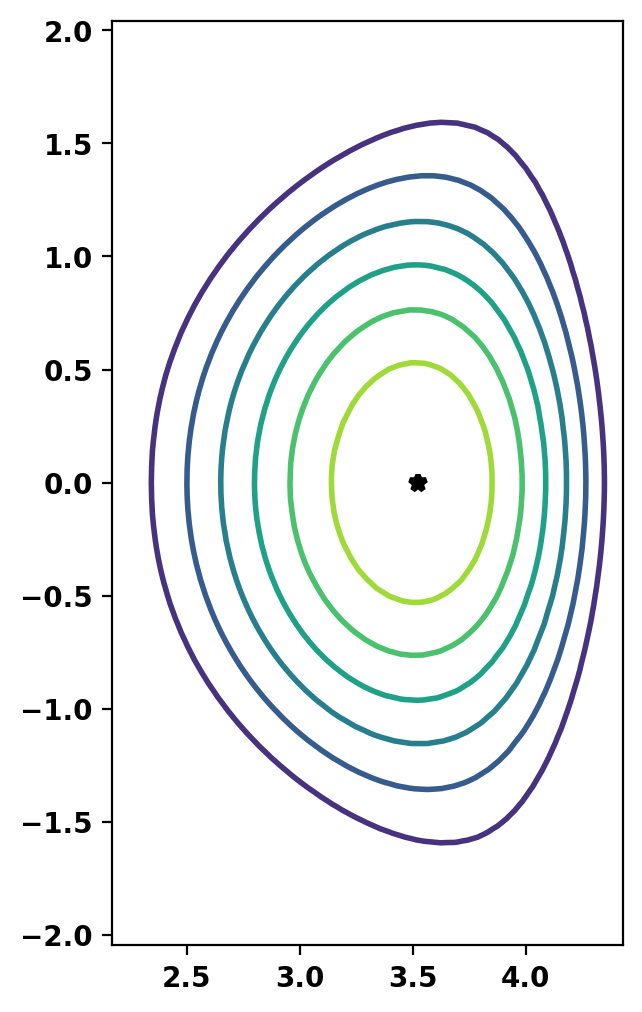
Compare updated profiles
We now use compare the updated results showing that all quantities are now well matched across the entire plasma.
